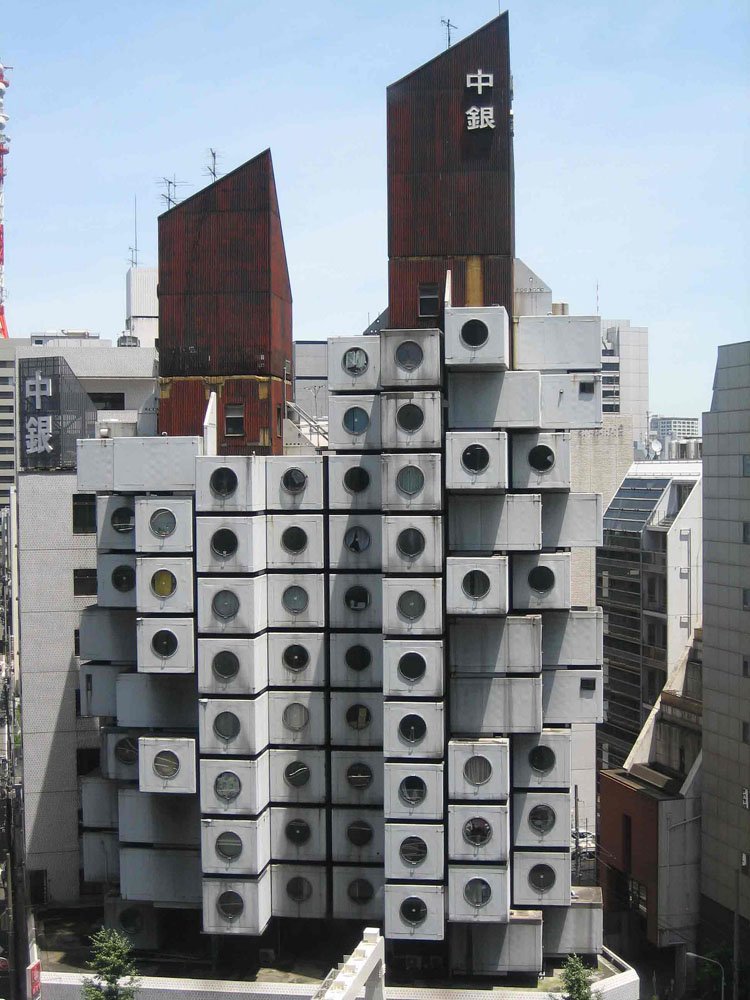
It may have seen better days, but when it opened, the Nakagin Capsule Tower was a shining example of cutting edge architectural ideas. Based on Japanese Metabolism, an architectural philosophy which concerned itself with designing structures that mirror the principles of living organisms, each capsule of the tower was akin to a cell in your body.

The Metabolism movement also designed a variety of concept cities floating on the ocean, underwater, in space, and more. Postwar Japan, having suffered untold devastation, could be almost completely rebuilt. There were no shortage of homegrown ideas about what the new Japan should look like, many of them fantastical and abstract.

The intention in constructing the tower such that individual apartments could be attached or removed was to make it so that when you wanted to move to a new location, rather than moving all of your stuff, your entire apartment could be moved at once. Ambitious and exciting, if not as practical in the end as the designers hoped.

The folly of built-in appliances becomes apparent when you take a look at the 1970s era technology on offer. Reel to reel audio, CRT televisions and rotary telephones have all been crammed into smartphones now. But the few remaining residents are all in love with the place, refuse to move out and fight any city effort to demolish it. Given how cozy and charming the pods are, even if basic utilities often stop working for days or weeks at a time, it's easy to see how they became so attached.

Is there a future for this style of construction? Possibly. Though the idea never caught on within existing cities, one could conceive of seasteads working like this. Already inherently modular by design, they could incorporate houseboats, or shipping container apartments transported by helicopter. Undersea colonies may work this way, expanded one apartment module at a time. Capsule hotels are all the rage after all. Perhaps the capsule tower, which took the logical next step, was simply ahead of its time.

slavery has evolved
Looking the thumbnail, I thought this was a huge stack of washing machines! Crazy cool architecture!
Awesome post! I am an architect who posts on here about design pretty regularly! you have my following.
I live in Montreal and this reminded me of this bldg created from expo 67...http://www.habitat67.com/en/
I live in Montréal as well, and I was about to post that, but you were much quicker hehe :)
Looks like a stack of washing machines :)
amazing building
Truly breathtaking architecture
If only there was more like it.
This is cool! You're one of the few people I'm glad to have followed here.. Always posting interesting material!
I came across a post yesterday by @michaelmatthews called How To Build Freedom Island. While the article has a definite philosophical overtone, there's some interesting concepts in regards to hexagonal platforms and their architectural strengths when used in a modular fashion.
For seasteading, I think the most realistic and affordable approach is simply to buy up and then repurpose aftermarket cruise ships. They have already paid for themselves carrying tourists, so they can cost a lot less than building a custom floating structure, and they already have everything onboard that a seastead would need. Add some wind turbines, solar panels, replace the fuel tank with a fresh water tank and off you go.
I will pass. I have no interest in a home which is smaller than a prisoners cell. I get enough of that in my office cubicle. Just because it is compact and space efficient, does not mean it is practical or very very livable.
Lots of high density urban building were designed and created in the 70's. Most for lower income family. Almost all are now gone in the U.S. They became a breeding ground for crime, victimization, and a symbol of poverty. Cities such as Chicago, New York, and Detroit have taken action to remove the dilapidated structures as part of neighborhood revitalization projects.
As it turns out, humans are not hamsters. We do not thrive in compact living pods. So, if you want this lifestyle, I am sure you can find an abandoned one in a big city somewhere, enjoy.
You're a ray of sunshine on a cloudy day, friend.
Yeah, I am a regular "Mr. Sunshine". :)
You say "humans are not like hamsters" but really, humans are not all alike are they? What works for one person doesn't reliably work for everybody. I appreciate compactness and efficiency.
It's one of the reasons I am big into high powered electric bikes, Soylent, solar tiny homes and things of that nature. Probably I would want something bigger than this too, but not by much. A modest geodesic dome probably.
Anyway you and I are different. I like that. What a boring world it would be if we were all the same. Surely this planet has room on it for many different kinds of people, teaching us by their existence that there are many right answers to the question of how to live your life.
Cool design, thanks for sharing, @alexbeyman!
Wow that is amazing for 1972.